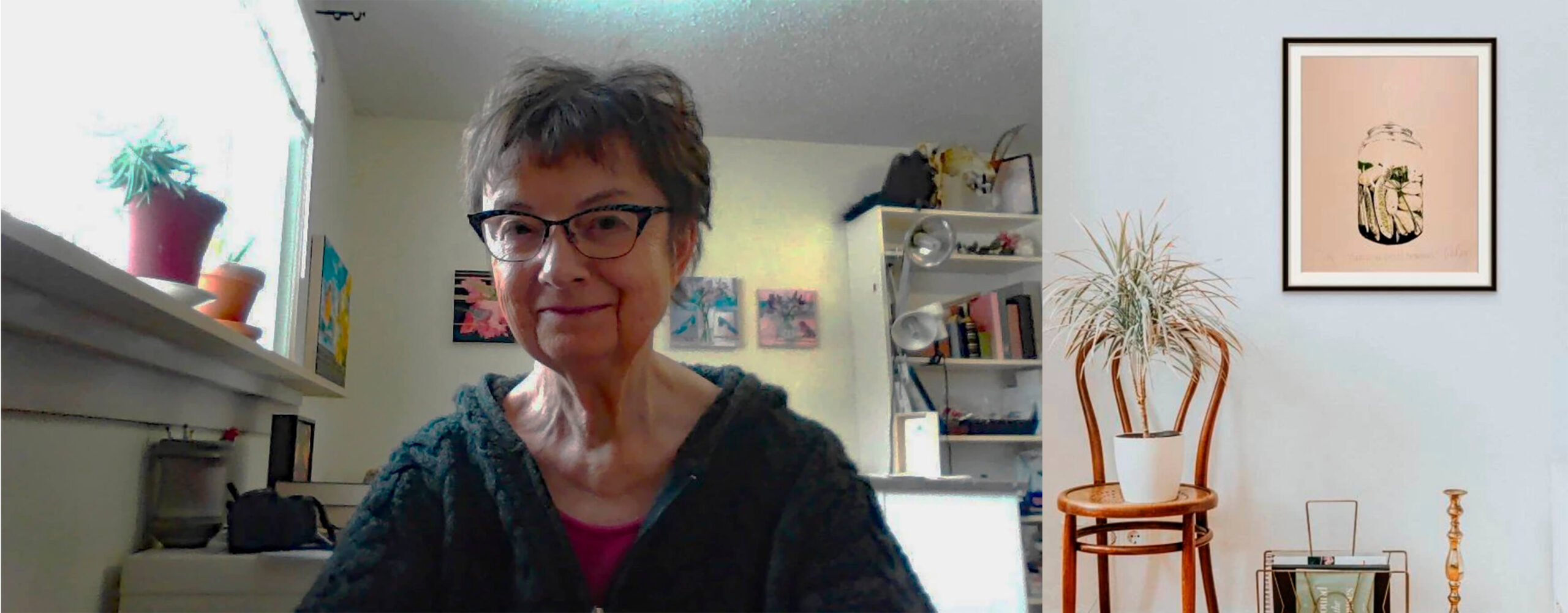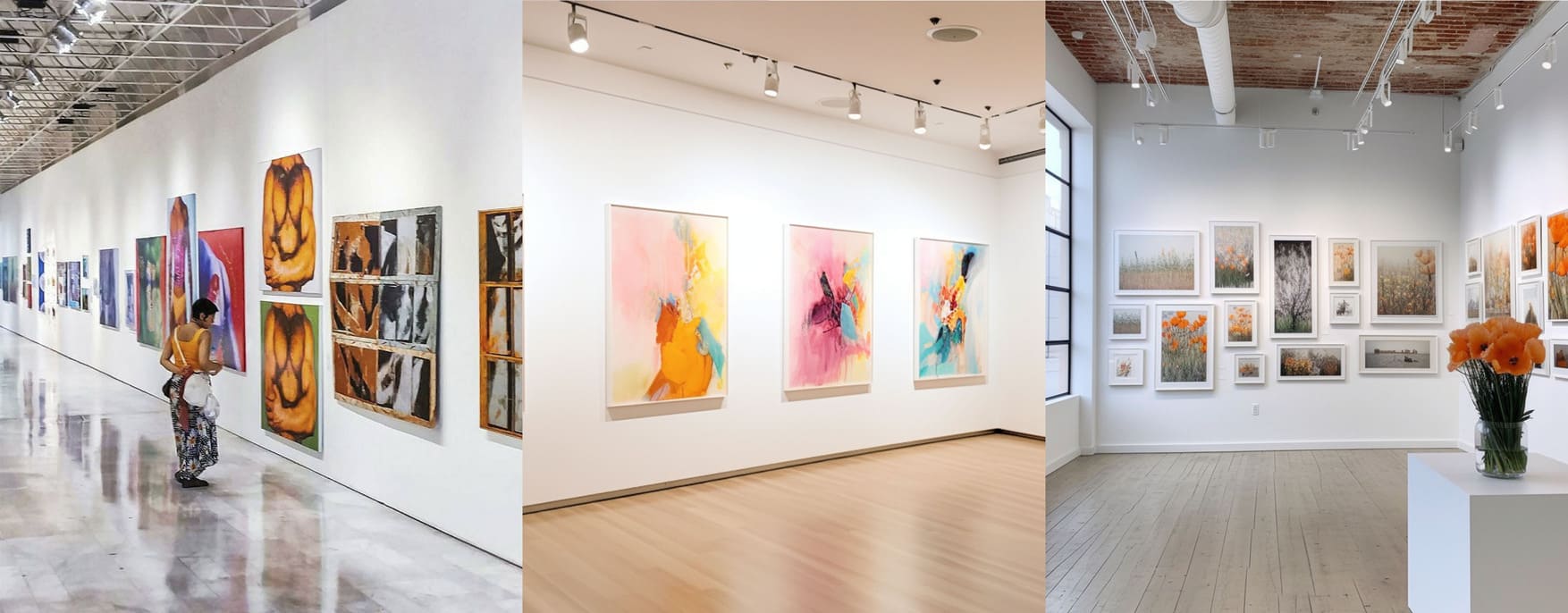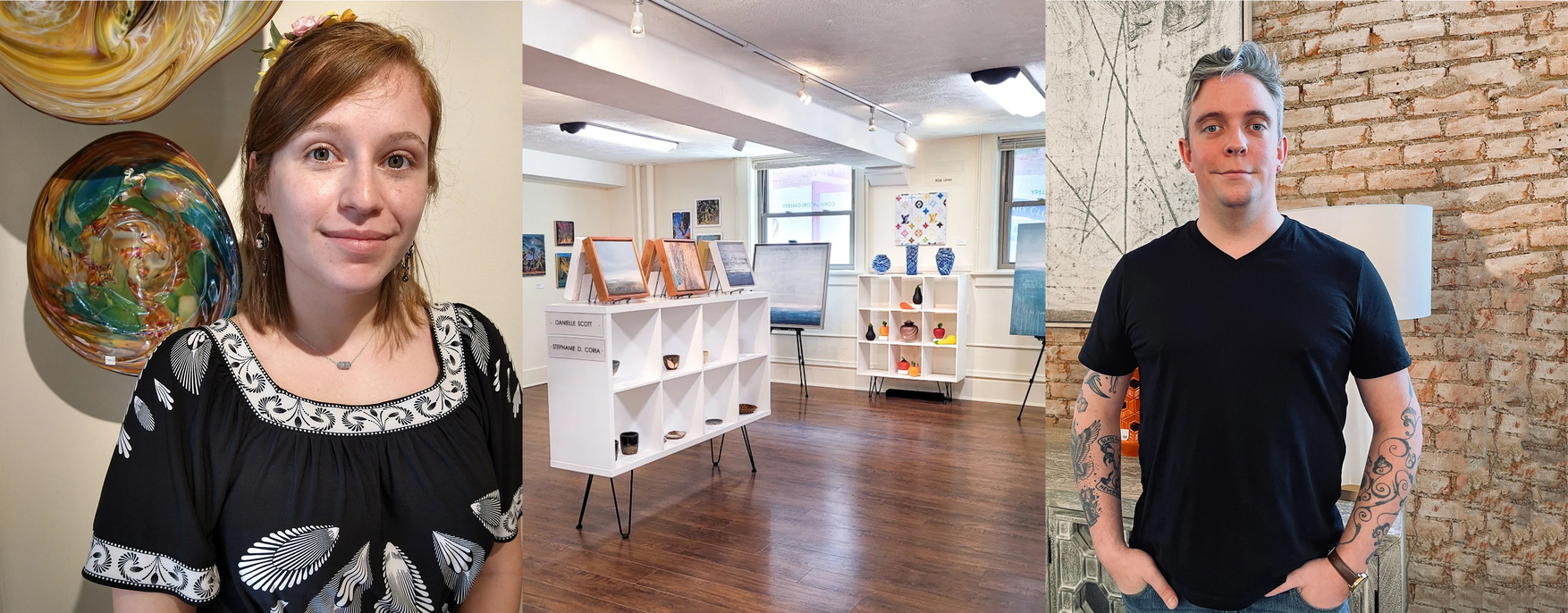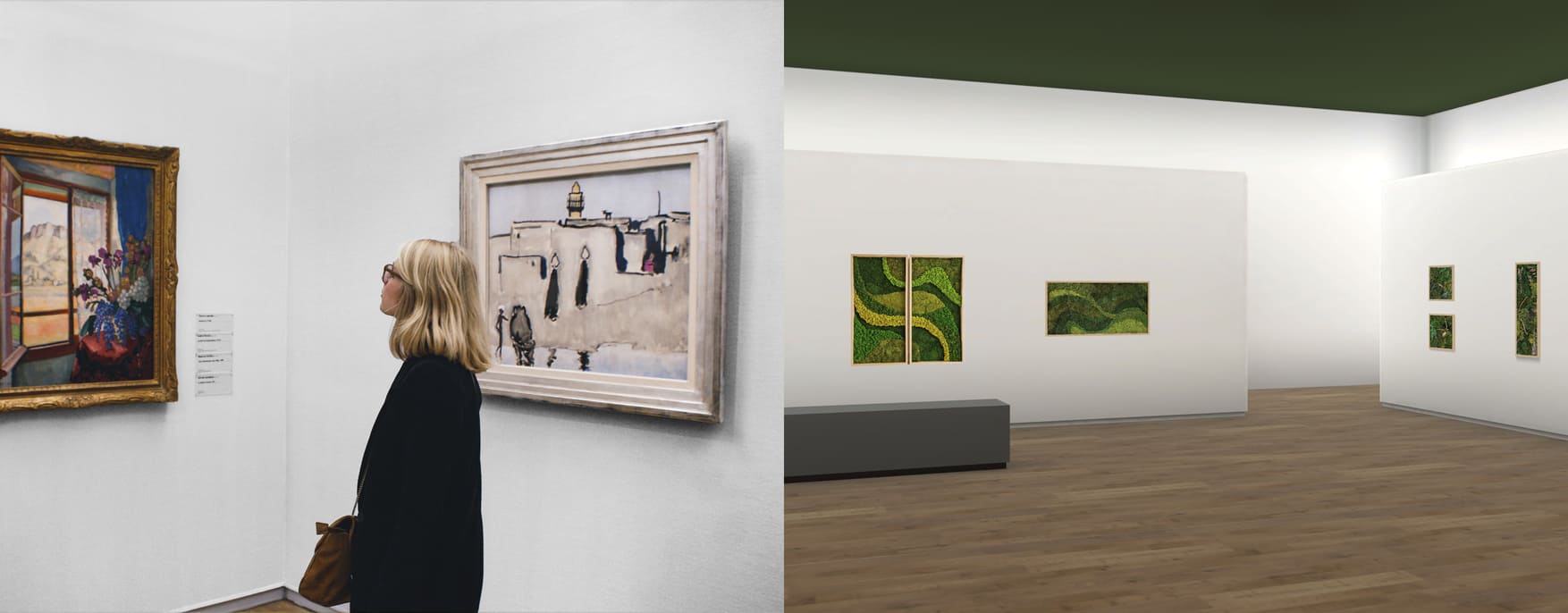Artist
Interview with Laureen Marchand: how digital tools can help you create a successful online gallery
When Laureen Marchand saw there was a lack of spaces for artists to showcase their work in her local city, in the remote region of Val Marie, Canada, near the Grassland National Park, she turned a need into an opportunity with the help of digital art marketing tools.
With more than 30 solo shows and 50 group shows under her name, she had the know-how to represent and showcase Saskatchewan art and artists, and then the Grasslands Gallery Online was born. And even though her main work happens online helping this small community of artists reach a global audience, she took it one step further bringing her art to in situ exhibitions with the help of ArtPlacer’s Art Show Planner.
We sat down with Laureen to talk about her creative journey as an artist and how digital tools have helped her build a platform for herself and the artists she represents.
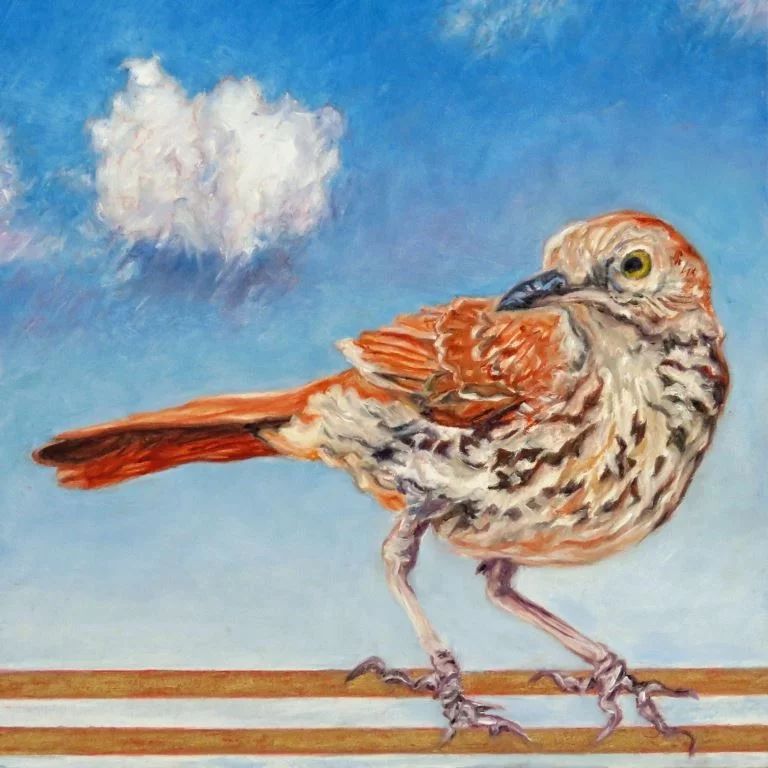
“Scattered” original artwork by Laureen Marchand.
Could you share with us a bit about your art background?
Well, I’ve been painting since I was 16. I always did what I called “making things”. I got craft books from the library as soon as I knew there were libraries, and I’d make things, the one I remember the best is the Japanese garden I made in my bedroom closet.
When I was 16, a new girl moved to my school, she came from a different city, and she had been good at art and had taken art classes all her life. I met her in grade 11 and when I applied to go to college the following year, I applied to go into a Fine Arts program. It had never crossed my mind that it was something that a person could do, but I guess when I met her it was like the rain fell on already growing seeds. And ever since then there’s never really been anything else I wanted to do.
Being an artist is the thing that has the most meaning to me out of everything else I do.
I also operate Grasslands Gallery Online, which is Saskatchewan’s only fully online professional commercial art gallery. It’s just over 2 years old.
I began working on it in May 2021, in response to the losses that artists had in terms of exhibition venues during that time, and also because a long-standing member of the art community in my sparsely populated Canadian province had died suddenly and tragically, and he had operated a very well-established gallery for about 30 years. I wasn’t setting out to fill his shoes, but I thought that maybe I could just provide a few more opportunities to artists who had lost so many spaces already. This is an online gallery because I live in an extremely unpopulated region, in a village called Val Marie, near the Grasslands National Park, which is 300,000 acres of prairie grasslands.
When I first moved here I operated a brick-and-mortar gallery during the summer season, because there are visitors to the Park. Five years in, I realized that I had created a full-time summer job for myself, which meant that for 6 months of the year, I wasn’t painting. I decided that other people could open galleries, but only I could make my art.
But this online gallery is different because I don’t have to have the doors open for a certain number of hours. Digital galleries are essentially open 24 hours a day but it’s all online. In our model, the artist retains the work in their studios until a purchase is made, and then they ship and get paid back the shipping costs that are covered by the client. So, the artists get paid and get recompense for any shipping costs they have.
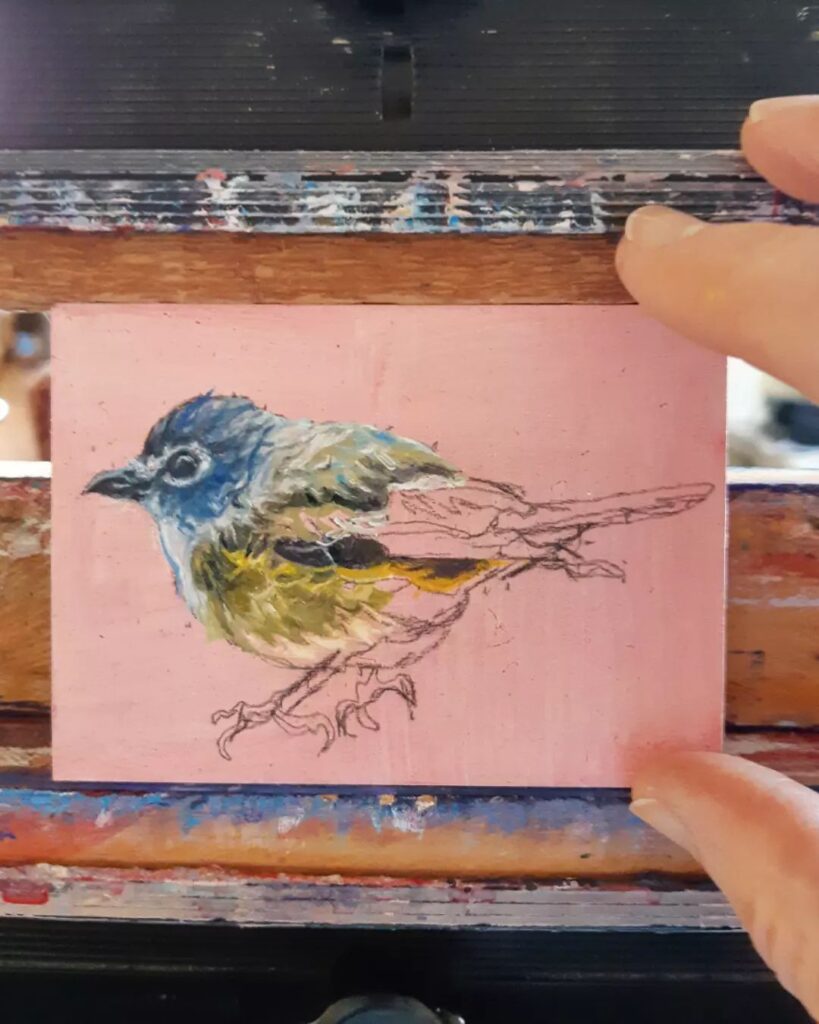
Work in progress of a small format artwork by Laureen Marchand.
You have a really broad experience and have done numerous art shows through the years. One of the things that you mention is how your surroundings have impacted this prolific career. What is your art process and how does it relate to your surroundings?
Well, I am a painter, and I paint fairly. I paint realistic-looking things. People are always surprised when they get up close to them to see that it just devolves into paint and there’s nothing smooth about it. It’s quite painterly, it’s just that they’re small pieces.
I painted figures for almost 20 years. And then one day, in the middle of getting ready for an exhibition where I needed to have paintings of those figures, it was like they walked out and what they left was the places that people inhabit or the things that people make up, so that that might be the landscape or the things they handle.
My subjects tend to be florals, birds, and sometimes landscapes. I don’t paint landscapes as often. It’s a spectacularly beautiful landscape, its hundreds of kilometers of rolling hills and sandy buttes that are changed daily by the wind, and more endangered species in flowers, birds, and animals than most people ever think of.
It’s very silent. I moved here 14 years ago, at the time a researcher who specializes in silence came to spend 2 weeks in the region. He defined silence as a place where you could go longer than 15 minutes without hearing a human-made noise. On his first morning here he went into the park, and he almost did. But then, far off in the distance, he could hear one of the ranchers, who lives on the edge of the park driving a tractor, something that was happening 30 kilometers away.
The air is so clear and dry. and the place is so silent that you can hear sounds that you wouldn’t be able to hear in an urban environment. So just by going a little further into that country, he ended up declaring this one of the world’s last silent places.
It’s silent in terms of human noise. It’s not silent in terms of birds and animal sounds, or the sound of the wind. The wind blows a lot, so you can almost always hear the wind. and it’s and it’s very beautiful. Even when I’m not painting the landscape. I can’t help but be aware that I’m privileged to live in a place like this that has such beauty.
And the way that has affected my art is that I look for ways to help people see what a joy nature is. Like many people, I’m concerned about climate change and changes in our natural environment, but I’ve chosen to make things that aren’t confrontational and don’t try to punish people for lack of awareness. I want to create the beauty that makes them value what they see.
Right now I’m painting very tiny pictures of birds on little tiny panels, these are 3 and a half and 3 and a quarter inches. Because I think if you can hold it in your hand, it feels more real, and they’re all the birds from here because we’re on a flight path and migratory flight. They don’t live here, they come through here. That’s my only requirement. I have to have seen it, but I have a lot of bird feeders, and all the town birds stop here, and the country birds stop at a close friend mine’s just outside the village, so I have access to all of them.
A view into Laureen Marchand’s studio life.
You mentioned you looked to portray or capture the beauty that is unseen in city landscapes. How do you explore the notion of beauty outside those, let’s say, conventional or modern concepts?
I don’t think I have a greater vision than many people but I have the privilege of encountering experiences that a lot of people don’t. I’ve always had the idea, since I was pretty new with this, that if I could paint something so it looked the most like itself. When I paint an object, a bird, an animal, or a human, I do so it looks the most like itself, that might give the people the opportunity to see themselves in it.
When I was painting people they weren’t pretty realistic, they were life-like but they weren’t intended to be portraits. They were intended to allow the viewer to themselves in that situation, not to have the human face be a barrier.
When I’m painting landscapes, I paint them the most like they are, then they can become more real to the viewer. Because I get to invent things and make colors brighter and stripes sharper, then maybe I get to create a more vivid experience than someone seeing a bird fly by when they are busy and they don’t even notice.
The flowers I paint might be dying but they’re still beautiful, so maybe someone can look at them and remember an experience like that, or look at how beautiful that dying thing is. Maybe other things are beautiful, even though they’re not perfect.
Opening night of the Grasslands Gallery art fair booth at Art Now.
How do you conceptualize your exhibitions and your shows around these types of experiences?
The artists I represent are really varied in the way they make art. I’ve got artists who create abstract landscapes, pure abstractions, or very detailed florals. I seem to have a surprising number of bird painters. I didn’t go looking for them, but that’s it. It seems that some of the artists who joined the gallery started painting birds during COVID-19, and I think it was because they could hear them.
When I’m putting an exhibition together or a collection of work, I’ll look for a theme where I can include all these different styles of work. I’m allowing all the artists to be involved, so it’s up to me to find a theme that they would be comfortable with.
I try to come up with themes that will allow as much contribution as possible because I don’t want to exclude people. Of course, as a gallery owner, I want to show good work but once I’ve made that decision, I’m assuming my artists are making good work.
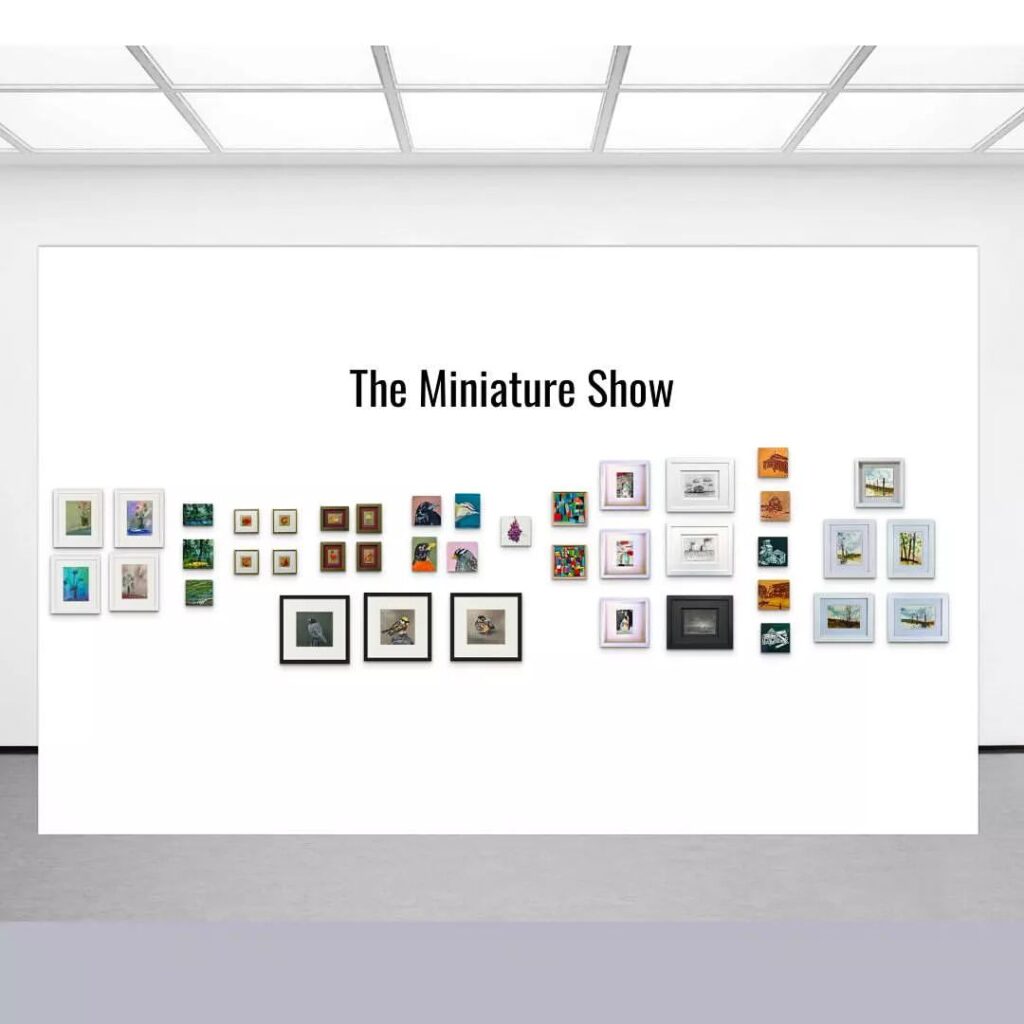
“The miniature show” is an example of an art fair booth showcasing small format artworks by the Grasslands Gallery Online designed with ArtPlacer’s Art Show Planner.
How did the Grasslands Gallery come to be? How did you start representing this group of artists?
I started pretty small with artists whose work I knew and liked. Some of them were already exhibiting with galleries. I left that decision up to them as to whether they wanted to exhibit with more than one. Some of them were artists who were kind of displaced by the gallery that closed because its owner died.
I don’t require artists to show exclusively with me, because I can’t offer shows that someone can walk into and I don’t offer solo exhibitions. I figured, if the artist were happy in their existing galleries then I was happy too, because I feel like the more opportunities there are for them to show their work, the better.
Although it’s an entirely online art gallery, I have taken it to a couple of in-person art fairs. I’ve shown my artists across the way from another gallery showing the same artists. I show my work, and a gallery, which also shows my work is there, but it feels like collaboration rather than competition. I’d rather keep it that way, having that openness especially now because it’s not a big community.
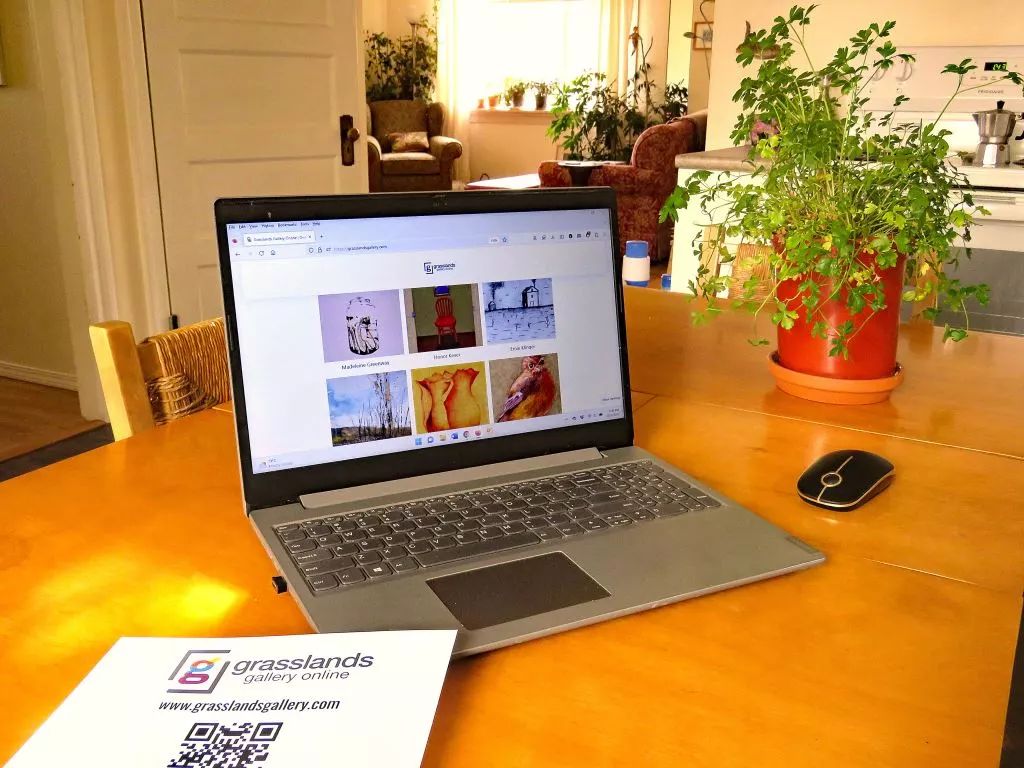
Laureen Marchand operates a fully digital online art gallery.
What do you think was the main benefit of going fully digital with your gallery?
For me it was practicality. It’s the only way I can realistically do it. But also, it’s what allows an artist’s work to be seen outside just one building. From the very first artwork product page I built on Woocommerce, I was using the ArtPlacer Widget for Sample Rooms, and that allows people to feel like they don’t have to visualize what 8 inches by 10 inches is like, they can actually see it in relationship to something.
This makes a huge difference in the way that online viewers can relate to the work. They can see how big it is because there’s a chair next to it, or a plant or it’s set in a bedroom.
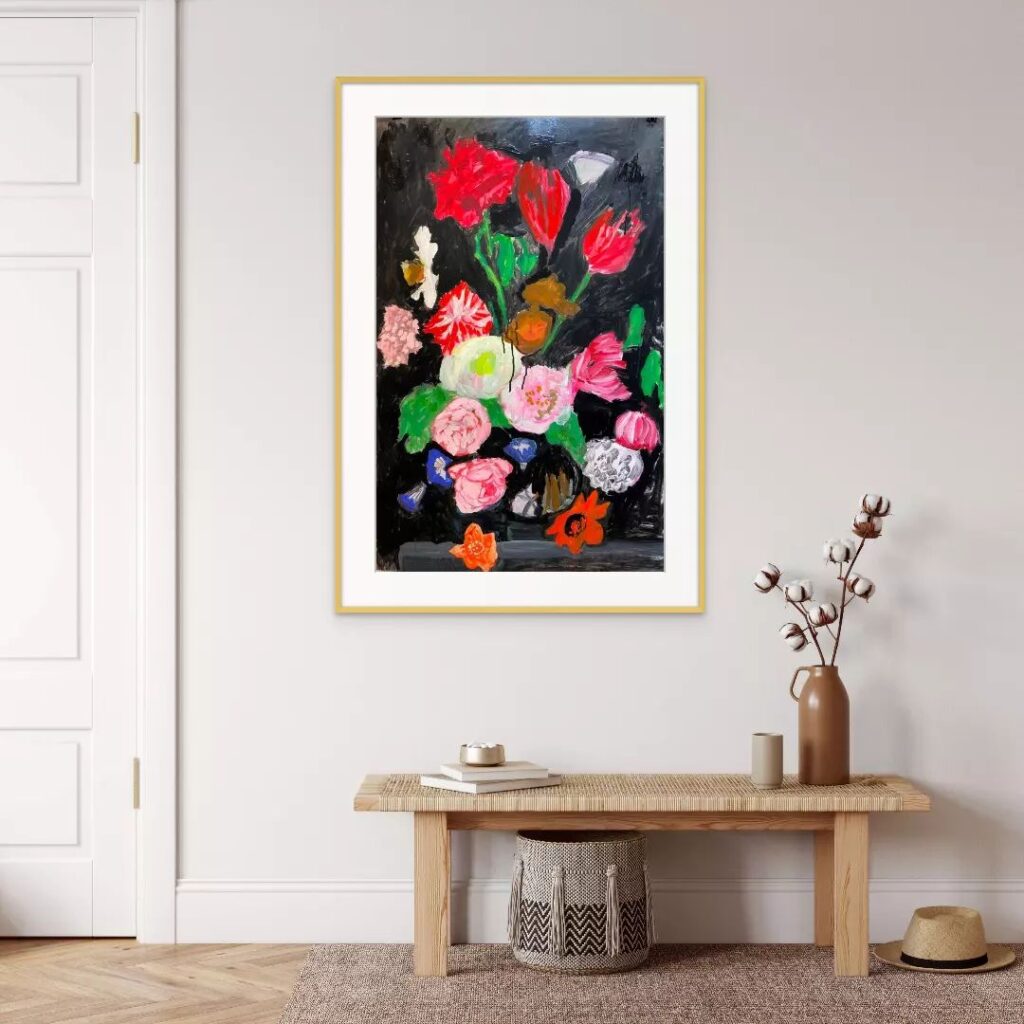
Showcase of floral artwork by artist Dawna Rose in a Room Mockup, represented by the Grasslands Gallery Online.
How do these art marketing tools help you promote your artist’s work?
These tools let you see how you can relate to a piece physically. That’s huge. Another thing that I think it does is that ArtPlacer has these sorts of aspirational Room Mockups. It’s like, if I bought that painting I’d clean up the floor, you know. and I think that’s a good thing because art enhances daily life, and even if someone doesn’t end up cleaning up they brought something into their home that is only going to make it nicer.
When I first launched the gallery, people kept telling me how much they liked to be able to put frames on things in the Sample Rooms Website Integration from ArtPlacer. That’s important for me as an online dealer because a lot of the works that my artists sell aren’t framed, people can ask me about framing if they want to. Then I discovered I could start making my frames with the Frame Builder so, sometimes I will copy a frame that one of my artists tends to use regularly, or that I tend to use regularly.
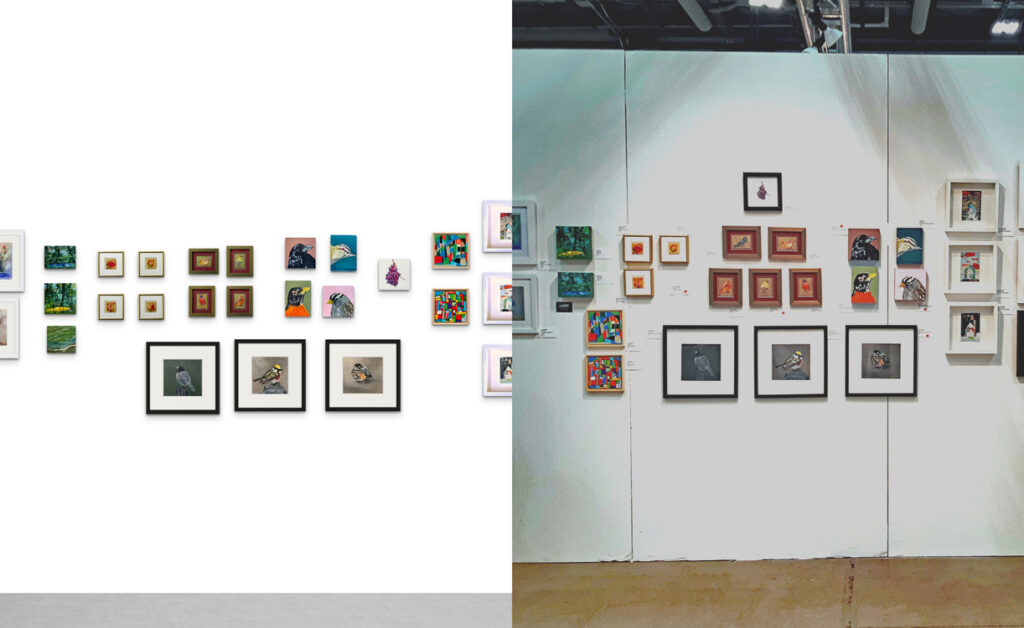
Grasslands Gallery in situ booth exhibition curated with ArtPlacer’s Art Show Planner.
As someone who has taken its online art show to a physical exhibition, how has it been working with ArtPlacer’s Art Show Planner?
It made a world of difference. I’ve had a lot of exhibitions. Art fair booths aren’t that big and it’s great to be able to plan it first and see what things would look like in exactly the right size in that space.
With the Art Show Planner, I can create a wall that is the right size and start designing the exhibition. So, I know what it’s going to look like before I go. I’ve been at this art fair twice, and the first time I think we made a few small changes. The second time I was more used to the planner and the space, and there might have been some slight spatial changes between groups of artworks but everything went up the way I had designed it in the planner. I wouldn’t like to do it without designing it in advance.
There are software that architects use to do three-dimensional rooms but is way too complicated. Using the Art Show Planner, I just have to “drag and drop”, you just put things where you want them to be and move them around, then print the plans and take them along.
I spend a lot of energy trying to get the screws or nails into those walls. If I had to design the exhibition at the same time, I don’t think I could do it. There’s a physical factor that slows things down. You want the creative factor to be as easy as possible and that’s why the Art Show Planner just made my life so much simpler. It’s pretty intuitive.
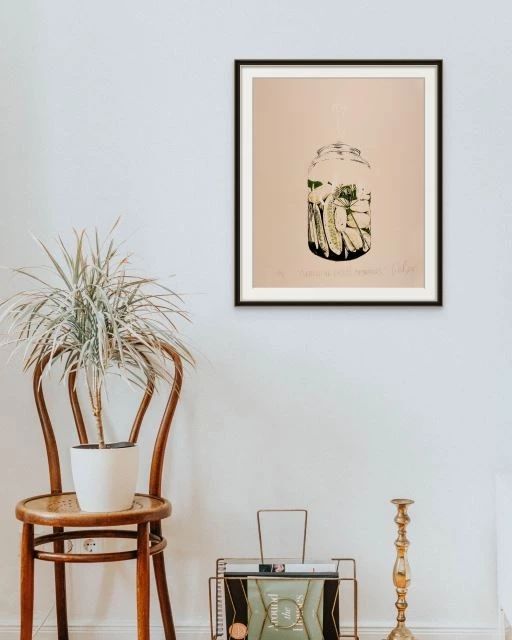
“Fermenting Excess Cucumbers” by Madeleine Greenway, showcased in a Room Mockup by the Grasslands Gallery Online.
What advice would you give to someone considering opening their own online art gallery?
Working with artists is always fascinating, they’re creative and friendly. How many communities can you work with where people are spending their days trying to do good? Because that’s what artists do. They try to create beauty, awareness, or in some way improve and enhance the world, and even educate. That’s really satisfying
Doing at a distance requires a lot of trust. When you’re speaking to someone face to face you can see their expression, and you can tell if what you’ve said didn’t make sense, or if they didn’t understand it, but we do everything by email, and so it takes trust in both parts to believe that the other person has your best interests at heart. I think that’s really worth striving for.
I think it works better for everybody if you can build relationships. I started with an artist’s gallery agreement. I outlined everything I could think of, all my expectations, what the artists could expect of me, and what I wanted to expect from them, and I used it to create a foundation so that everybody knew what they were getting into. And of course, we’re all human, mistakes will be made, things will be forgotten, and it’s part of my job to gently remind people when they’ve missed something. I need that depth too.
I think it’s an opportunity not only to show art but to build some really interesting relationships. I’ve met people and artists through it that I wouldn’t have met otherwise.
I’ve met clients through it, too, that I wouldn’t have met. Some of my clients are seasoned collectors, some of them are brand new and it’s an opportunity for me to smooth a path between the artists and the person who’s buying the work.
I have standardized things as much as I can to start with. but as soon as I get a notification that something has been purchased, I send a personal email telling the person what to expect. I send another email when the artist has shipped the work. And then another one once I can tell has arrived to say “I hope you’re loving the artwork and if you have any questions or comments, please let me know”. Most of the time people reply that they are happy with it.
When they reply, I’ll ask if I can use their comment with just a first name and city location on my “Happy Customers Page”. Those who’ve said something nice are usually really pleased because they like what they bought and they’re invested in it. This is another way to promote the artist’s work.
I would say if someone wanted to do it themselves (creating an online gallery) they need to have a structure and clarify it as much as they can to the artists and themselves. Be prepared to enjoy building relationships.
Editor’s note: this interview was edited for length and clarity.
